Somatic growth of the Pacific stock of Japanese sardine deteriorated during the 2010s corresponding to its stock recovery. The previous study detected stronger density-dependent growth in the 2010s than in the 1970s and 1980s and suggested that lower mesozooplankton biomass during the 2010s in the summer feeding grounds (FG) controlled the strength of density-dependence, however, the effect of FG area has not been examined. After the 2014/15 oceanographic regime shift, the Oyashio area diminished, the sea surface temperature of FG increased principally during winters, and net primary productivity (NPP) increased in the northern FG around the Oyashio, whereas NPP decreased in the southern FG around the Kuroshio-Oyashio Transition Zone. To explore potential causes of variability in annual increments of body weight by age of this stock during 2003–2020, we performed a generalized linear model (GLM) analysis using biomass and recruitment of this stock, the Oyashio area, and NPP of northern and southern FGs as candidates of explanatory variables. The GLM results suggested that the biomass of this stock and the Oyashio area was responsible for the recent growth decline of age-0 fish, and age-1–3 fish, respectively.
View full abstract
